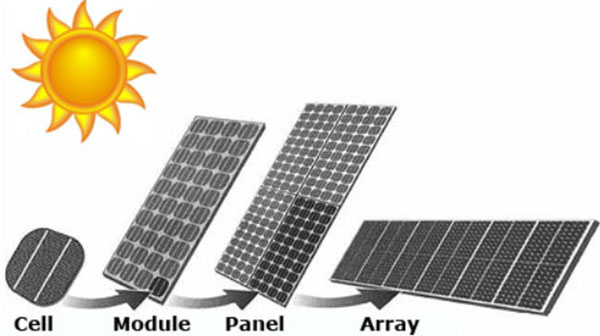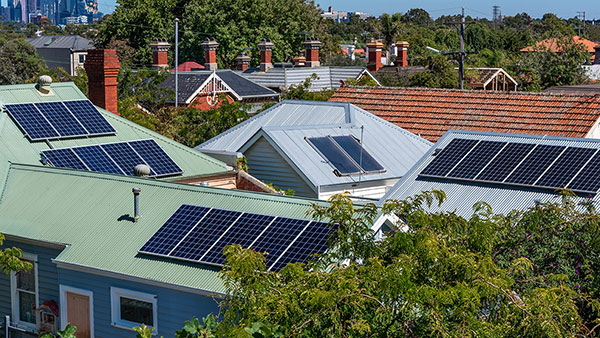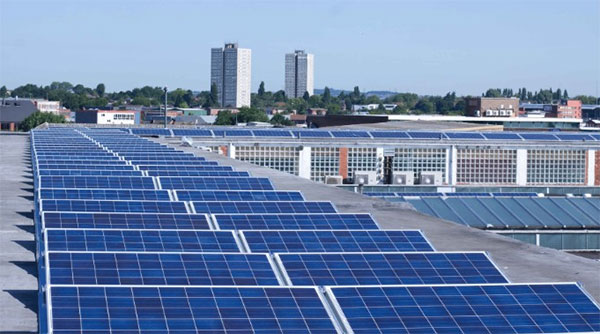Description
A solar cell is a single electrical device that converts sunlight into electricity through the photovoltaic effect. A solar panel, on the other hand, is an assembly of multiple solar cells linked together to increase the total electrical output for practical use.

Solar Cells
Solar cells, the core technology behind solar energy, transform light from the sun into electrical energy.
How They Work
Solar cells are made from semiconductor materials like silicon. When sunlight hits a solar cell, it knocks electrons loose from their atoms, generating an electric current.
Key Parameters
- Efficiency: Typically ranges from 15-20% for monocrystalline cells to 10-13% for thin-film cells.
- Power Output: Generally falls between 0.5 and 4 watts per cell.
- Size: Commonly about 156mm square for each cell.
- Lifespan: Can last over 25 years.
Cost Factors
The price per watt can be from $0.50 to $1.00, with the total cost depending on the number and type of cells used.
Solar Panels
Solar panels consist of multiple interconnected solar cells and are used to generate electricity on a larger scale.
Composition
- Solar Cells: Convert light to electricity.
- Glass Casing: Protects the cells from the elements.
- Frame and Backsheet: Provide structure and environmental protection.
Performance Metrics
- Rated Capacity: Ranges from 250 to 400 watts for residential panels.
- Efficiency: Average around 15-18%.
- Dimensions and Weight: Standard panels measure around 1.6 meters by 1 meter and weigh between 15 to 25 kilograms.
Installation and Cost
Installation costs for residential systems can vary, generally between $15,000 and $25,000 before incentives.
Durability
Solar panels can remain functional for over 25 years, with little maintenance needed.
Solar panels represent a significant step towards sustainable living, and technologies like
Bifacial solar panels are pushing the boundaries of efficiency and practicality.

The Composition and Function of a Solar Cell
Solar cells are the fundamental units of solar technology, capturing sunlight and converting it into electrical energy.
Detailed Structure of a Solar Cell
At the heart of a solar cell's structure is a thin semiconductor wafer, typically made of silicon, which is doped with other elements to create positive (p-type) and negative (n-type) layers. These layers establish an electric field at the junction between them. When light photons are absorbed by the semiconductor, electron-hole pairs are created. Due to the electric field, electrons move toward the n-type layer, and holes toward the p-type layer, generating an electrical current.
The top layer of the cell is coated with an anti-reflective material to reduce the loss of sunlight by reflection. It's also etched with fine patterns to maximize light absorption. A grid of metallic contacts on the surface collects electrons from the n-type layer, and a solid contact layer at the bottom collects holes from the p-type layer.
The Electrical Characteristics of a Solar Cell
A solar cell's electrical characteristics are crucial for its performance:
- Current (I): This is the flow of electrons generated when the cell is exposed to sunlight. The maximum current (Isc) occurs when the cell's external circuit is shorted.
- Voltage (V): The potential difference created by the electric field is represented by the voltage. The maximum voltage (Voc) occurs when the circuit is open.
- Power (P): The product of the current and voltage (P=V×I) gives the power output. The power output of a typical solar cell can be around 0.5 to 4 watts under standard test conditions.
Efficiency Factors for Solar Cells
Efficiency is a measure of a solar cell's ability to convert sunlight into usable electricity and is affected by several factors:
- Material Quality: The purity of the silicon and the quality of the semiconductor materials greatly influence efficiency.
- Electrical Configuration: The arrangement of the contacts and the resistance of the cell affects the flow and collection of electrons.
- Optical Enhancements: Anti-reflective coatings and texturing increase light absorption, improving efficiency.
Solar cell efficiencies can range widely, with commercial cells typically around 15-20% and advanced models exceeding 22%. Higher efficiencies mean more electricity generation per area, which can be crucial for maximizing power output, especially in limited spaces.
The cost of solar cells and ultimately solar panels can depend on the materials and the manufacturing process, but the
price per watt has been decreasing over the years, making solar a more accessible option for renewable energy. As of the latest data, costs can go as low as $0.20 to $0.30 per watt for the cells themselves, thanks to technological advancements and economies of scale.
Solar cell technology is a rapidly advancing field, with research focusing on new materials like perovskites and organic photovoltaics which offer the potential for lower costs and higher efficiencies. With increasing demand for renewable energy sources, the development of solar cells represents a critical step towards a more sustainable energy future.

The Construction and Efficacy of Solar Panels
Solar panels harness the sun's energy and convert it into electricity, playing a key role in the renewable energy landscape.
How Solar Panels Are Constructed
The construction of solar panels begins with the assembly of individual solar cells, which are the energy-converting units. These cells are typically made from silicon, which is known for its semiconducting properties. Manufacturers mount a series of these cells onto a panel, connecting them in series or parallel circuits to increase the voltage or current respectively.
Each solar cell is sandwiched between layers of protective materials. The front side, facing the sun, includes a glass layer that offers durability and allows light to pass through to the solar cells. Underneath the cells, there's a backsheet, which is usually a type of polymer or plastic that protects against environmental damage. To hold everything together, manufacturers use a frame, typically made of aluminum, which provides strength and rigidity.
The final component is the junction box, which is attached to the back of the panel. It houses the electrical connections that link the panel's circuits to the wider electrical grid or to a storage system.
Factors Affecting the Efficiency of a Solar Panel
Several factors determine the efficiency of a solar panel:
- Quality of Solar Cells: Higher-grade cells with fewer impurities convert sunlight to electricity more effectively.
- Temperature Coefficient: Solar panels operate less efficiently at higher temperatures. The temperature coefficient indicates the impact of heat on a panel's operation.
- Reflectance Efficiency: Anti-reflective coatings can reduce the amount of light that is reflected away from the panel, making it more efficient.
- Angle and Positioning: Panels angled to capture the maximum amount of sunlight naturally have higher efficiency.
Typically, the efficiency of a commercial solar panel is around 15-18%, with some high-efficiency models reaching above 22%.
The Longevity and Durability of Solar Panels
Solar panels are designed for longevity and durability, able to withstand harsh weather conditions including rain, wind, and snow. Most manufacturers offer warranties that guarantee their panels will operate at a certain level of their original efficiency after 25 years, often above 80%. The actual lifespan can extend well beyond this warranty period, with many panels remaining functional for 30 years or more.
The durability of solar panels is due in part to the quality of materials used. For instance, the glass casing is tempered to resist impact and the backsheet is designed to prevent moisture ingress and protect against UV damage. Frames are corrosion-resistant to ensure structural integrity over the years.
In terms of cost, solar panels represent a significant investment, but they have become more affordable over time. As of the latest data, the average cost to install solar panels ranges between $2.50 and $3.50 per watt before incentives, making the total price for a standard residential solar system between $15,000 and $25,000.
The construction and efficacy of solar panels are key factors in the ongoing
transition to renewable energy. With continuous improvements in panel technology, manufacturing processes, and material science, solar panels are becoming more efficient and less expensive, broadening their adoption and impact on energy markets worldwide.
Comparison of Solar Cells and Solar Panels
The distinction between solar cells and solar panels is essential for understanding their function and application in harvesting solar energy.
Differences in Scale and Application
Solar cells harness sunlight to generate electricity through the photovoltaic effect. Each cell, about 156mm square, produces 0.5 to 4 watts. These cells power small devices, like calculators and watches.
In contrast, solar panels consist of multiple cells linked to boost power output. They meet diverse needs, from homes to power stations. A typical panel, around 1.6 meters by 1 meter, outputs 250 to 400 watts.
Electrical Characteristics and Comparison
The electrical characteristics of solar cells include voltage, current, and power output, which are directly influenced by the cell's material and design. Typically, a single solar cell can produce an open-circuit voltage of about 0.5 to 0.6 volts. When multiple cells are combined to form a solar panel, the voltages add up, and the currents combine, resulting in higher power output.
In terms of efficiency, individual solar cells can vary, with monocrystalline cells usually being the most efficient at about 15-20% efficiency, while polycrystalline cells are slightly less efficient, and thin-film cells are generally the least efficient.
Solar panels' efficiency ratings are an average of the efficiencies of the individual cells and can be affected by the configuration and spacing of the cells within the panel. The overall efficiency of a solar panel system also considers losses due to wiring, inverters, and other system components.
Cost Considerations and Market Trends
Cost is a major factor in the adoption of solar technology. The cost of solar cells has decreased dramatically over the years due to technological advancements and economies of scale. Currently, the cost per watt for a solar cell can be as low as $0.20 to $0.30, making them quite affordable for a wide range of applications.
The cost of solar panels includes the cells themselves, the framing, the glass cover, the wiring, and the installation. Prices for residential solar panel systems can range from $15,000 to $25,000 before incentives, with the cost per watt installed falling between $2.50 and $3.50 on average.
Market trends indicate a continued reduction in prices as technology improves and demand increases. Government incentives and the growing awareness of renewable energy benefits are driving the expansion of the solar market. Moreover, innovations in
solar panel technology are making systems more efficient and durable, further increasing the value proposition of solar energy investments.
In summary, while both solar cells and solar panels serve the purpose of converting solar energy into electricity, their scale, application, electrical characteristics, and costs differ significantly. Understanding these differences is key for anyone considering solar power as a viable energy solution.

Applications of Solar Cells and Solar Panels
Solar technology is increasingly popular due to its sustainability and the decreasing cost of photovoltaic components. The applications for solar cells and panels are diverse, ranging from small-scale devices to large power generation facilities.
Standalone Solar Cell Applications
Standalone solar cells find their use in a variety of small-scale applications where low power output suffices. These include:
- Consumer Electronics: Solar cells power calculators, watches, and outdoor lights, which require minimal power.
- Chargers: Portable solar chargers for phones and small electronics utilize single or small groups of solar cells.
- Remote Sensing: In remote locations, solar cells power environmental sensors or communication devices, often with a small battery to store energy.
The power output of these cells generally ranges from milliwatts to a few watts, providing an efficient and cost-effective power source. The cost for these small-scale solar cells is minimal, often just a few dollars, which allows them to be integrated into a wide array of products.
Residential and Commercial Applications of Solar Panels
Solar panels are widely used in residential and commercial settings due to their capacity for generating significant electricity.
- Home Installations: Solar panels on rooftops can significantly reduce the electricity bills for homeowners. Residential systems typically range from 5kW to 20kW, depending on the size of the home and energy needs, and can cost between $15,000 and $40,000 before incentives.
- Business Installations: Commercial buildings often have larger roof spaces, allowing for bigger solar panel installations. Systems can range from 25kW to several megawatts, and the cost will vary accordingly but generally falls within $1.50 to $3.00 per watt, benefiting from economies of scale.
The efficiency of these panels is critical as it determines the amount of space needed for the installation and the potential electricity generation.
Large-Scale Solar Farms and Their Impact
Solar farms are a cornerstone of renewable energy strategy, designed to generate large quantities of electricity for distribution across the grid.
- Utility-Scale Power Generation: Large-scale solar farms can cover hundreds of acres and often have a capacity of tens to hundreds of megawatts. The Ivanpah Solar Power Facility in California, for example, spans approximately 3,500 acres and has a gross capacity of 392 MW.
- Environmental Impact: These installations can reduce the carbon footprint significantly by offsetting the use of fossil fuels. The efficiency of solar farms can range from 15% to 25%, and their lifespan is typically 25 to 30 years.
Solar farms can have substantial initial costs, running into hundreds of millions of dollars, but the cost per watt ($/W) can be lower compared to smaller installations due to economies of scale. Maintenance costs are also lower on a per watt basis.
In summary, the applications of solar cells and panels are diverse and expanding. With improvements in efficiency and decreases in cost, they are becoming an increasingly vital part of the global energy landscape.

Integration in Energy Systems
Merging solar technology with wider energy systems is key to a greener future. It's not just about setting up solar cells and panels. This effort extends to linking them with
energy storage options and
smart grid capabilities. Together, these steps enhance the sustainability and resilience of power networks.
Combining Solar Cells and Panels into an Energy System
Integrating solar cells into an energy system requires an understanding of how they fit into the existing energy infrastructure.
- Inverter:In homes, solar panels connect with inverters that transform the panels' DC electricity into home-friendly AC power. These systems can power household appliances or supply the grid.
- Transformer:For commercial and industrial setups, the systems scale up, adding transformers and power management to manage outputs up to hundreds of kW.
- Electric grid:Ensuring grid compatibility, solar integrations require synchronization gear to match voltage and frequency. This often involves advanced power electronics.
The cost of integrating solar into an energy system varies greatly depending on scale and complexity. For a residential system, integration costs can be a few thousand dollars atop the solar panel system cost, while commercial installations may incur higher costs due to additional equipment and engineering required.
Energy Storage and Solar Technology
Energy storage is a key component that enhances the value of solar power, allowing for the use of solar electricity even when the sun isn't shining.Modern lithium-ion batteries can achieve efficiencies of about 90-95%.
- Batteries: The most common storage solution for solar systems. For residential systems, battery costs can range from $5,000 to $7,000 for a 10 kilowatt-hour (kWh) system.
- Scale of Storage: The capacity of storage systems can vary significantly, from small batteries for home use to large-scale storage solutions for utility applications, which can have capacities in the megawatt-hour (MWh) range.
Smart Grids and Solar Power
Smart grids are traditional power networks evolved, weaving in renewables like solar to boost efficiency and reliability.
- Grid Management: Smart grids use advanced metering infrastructure (AMI) to manage energy flow more effectively and integrate distributed energy resources (DERs) like solar panels.
- Load Balancing: Smart grids balance the load by adjusting to the production from solar panels, which varies with sunlight availability.
- Demand Response: This involves adjusting power usage across the grid in response to supply changes from intermittent sources like solar power.
The integration of solar into smart grids can involve significant costs associated with upgrading infrastructure and implementing advanced metering and management systems. However, these investments can lead to substantial benefits in terms of energy efficiency and grid reliability.
In summary, integrating solar cells and panels into energy systems involves a variety of technologies and scales of application. The costs and efficiencies of these integrations are improving over time, contributing to a more sustainable and resilient energy future.







